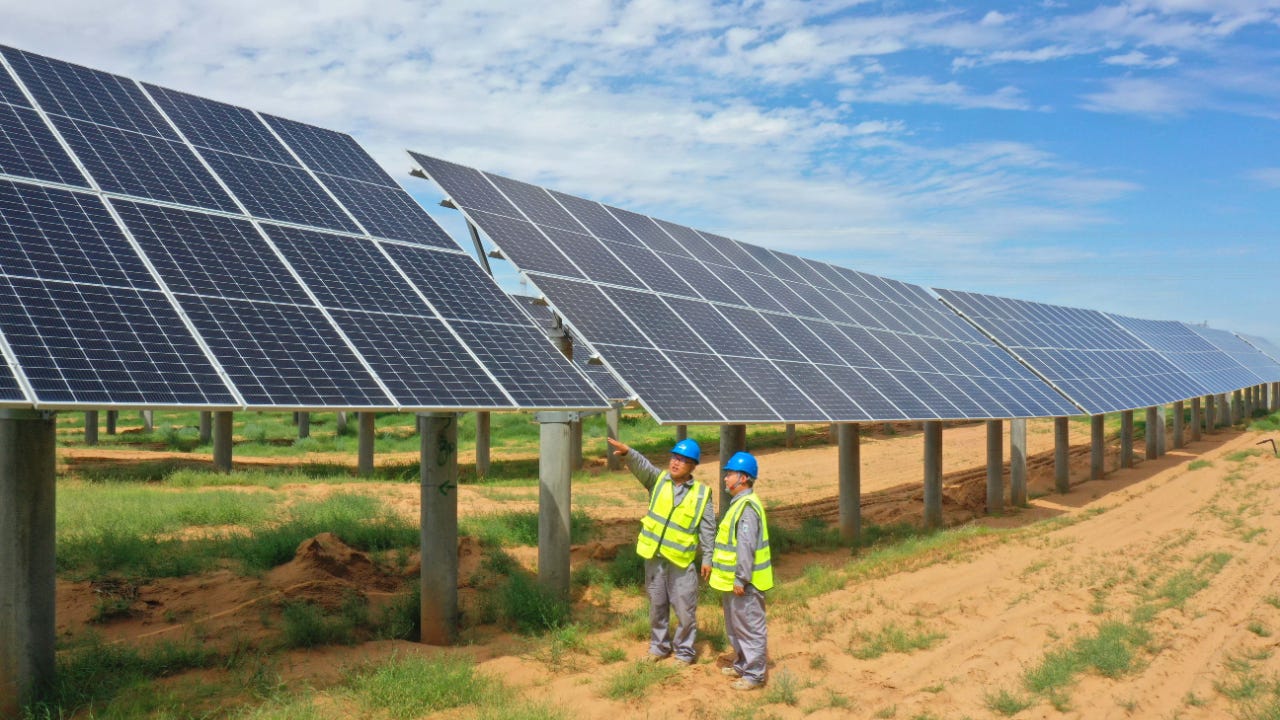How to invest in the solar industry

The Bankrate promise
At Bankrate we strive to help you make smarter financial decisions. While we adhere to strict , this post may contain references to products from our partners. Here's an explanation for .
As more countries seek to move away from fossil fuels such as oil and natural gas, renewable energy sources, such as solar, are poised to benefit from increased investment. Solar energy could provide 45 percent of the electricity in the United States by 2050 if the energy system is fully decarbonized, up from 3 percent in 2020, according to the National Renewable Energy Laboratory (NREL).
This kind of growth holds enormous potential for investors, but there are also risks to be aware of. Here’s what you need to know before investing in solar energy.
The rise of solar power
You might think that solar energy is a relatively new phenomenon, but using the sun as a source of energy actually dates back to the 7th Century B.C. when a magnifying glass was used to concentrate the sun’s rays to make a fire and burn ants. It wasn’t until 1767 that the first solar collector was created thanks to Swiss scientist Horace de Saussure. About 100 years later, French mathematician August Mouchet proposed solar-powered steam engines and worked with his assistant over the next two decades to build them.
Throughout the 1900s, research on solar power increased, leading to new discoveries and advancements. In 1993, Pacific Gas & Electric installed the first grid-supported photovoltaic system in California, which was the first distributed power installation. In 1998, a remote-controlled, solar-powered airplane set an altitude record of 80,000 feet in California.
Going forward, solar energy will be an important component of renewable energy. New buildings will be built using energy-efficient designs and technologies so that they won’t have a need for non-renewable energy. An increasing amount of the electricity needs of the U.S. will also be met using solar energy. Cars and airplanes may also find ways to use solar energy for their power.
Breakdown of the solar industry:
Several different types of companies at various points in the process make up the solar industry, and here’s what the main companies are involved in today:
- Manufacturing components and solar panels – These companies produce solar panels and components that are used to convert the sun’s energy into electricity.
- Installation of solar panels – These companies are involved in the installation of solar panels, often at a commercial scale and may provide financing solutions in addition to their installation offerings.
- Solar facilities – These companies operate facilities that generate solar energy and may also be involved in other renewable energy sources such as wind or hydroelectric plants.
Solar investments to watch
It can be difficult to know how to start investing, but you’ll generally have to choose between individual stocks and funds that hold baskets of companies.
Here are a few of the most popular.
Solar stocks
- First Solar (FSLR) – First Solar is a leading manufacturer of advanced solar modules, which it sells to a variety of customers including utility companies, distributors, and commercial and industrial buildings. The company expects to benefit from increased solar panel capacity over the next five years and beyond.
Market cap: $7.1 billion
2021 sales: $2.9 billion
- Brookfield Renewable Partners (BEP) – Brookfield Renewable Partners is one of the largest renewable power platforms in the world and operates hydroelectric, wind, solar and storage facilities in North America, South America, Europe and Asia. Brookfield generates strong cash flow and shares that with investors in the form of a dividend, which it hopes to grow by 5 to 9 percent each year.
Market cap: $22.9 billion
2021 sales: $4.1 billion
- SolarEdge Technologies (SEDG) – SolarEdge Technologies is a manufacturer of solar components such as inverters and power optimizers. These components convert DC power to AC electricity and help lower the cost of the system. The company’s goal is to become the leading provider of inverter solutions to the solar industry.
Market cap: $15.6 billion
2021 sales: $2.0 billion
Solar-based funds
- iShares Global Clean Energy ETF (ICLN) – This iShares fund aims to track the investment performance of an index made up of companies in the clean energy sector. The companies may produce energy from solar, wind or other renewable sources.
5-year annualized return: 18.5 percent
Expense ratio: 0.42 percent
Assets: $4.8 billion
- Invesco Solar ETF (TAN) – The Invesco Solar ETF is based on the MAC Global Solar Energy Index and invests at least 90 percent of its assets in securities that make up the index. Enphase Energy (ENPH), SolarEdge and First Solar are top fund holdings.
5-year annualized return: 28.5 percent
Expense ratio: 0.66 percent
Assets: $2.4 billion
- Fidelity Clean Energy ETF (FRNW) – The Fidelity Clean Energy ETF, launched in 2021, aims to track a Fidelity index of clean energy companies. Companies in the index distribute, produce or provide technology or equipment that supports the production of energy from solar, wind, hydrogen or other renewable sources.
Year-to-date return: -13.1 percent
Expense ratio: 0.39 percent
Assets: $29.9 million
Pros of investing in solar energy
There are many advantages to investing in solar energy. Here are the major ones:
- Sustainability – Solar energy is classified as renewable because we won’t run out of sunlight, whereas fossil fuels such as oil and natural gas have a limited supply.
- Environmental impact – Relative to fossil fuels, the environmental impact of solar energy is low. It has a much lower carbon impact and doesn’t damage the land the way that fracking and oil drilling can.
- Independence – The U.S. has certain parts where sunlight is abundant (such as the Southwest), which creates the possibility that solar energy could help it become less reliant on and even energy independent from other parts of the world that produce oil. You may even be able to put solar panels on your house and become energy independent as an individual.
- Growth potential – Because we are still in the early stages of solar energy, the potential for future growth is enormous. This is what attracts most investors to the industry, but that growth potential isn’t risk-free.
Cons of investing in solar energy
Despite the potential benefits of investing in solar energy, there are some concerns to be aware of.
- Inconsistent sunlight – One of the challenges of solar energy is the fact that the sun doesn’t shine all the time. The sun is only out during the day and even then, clouds can make solar energy a challenge. Because of this, storage solutions for solar energy hold great opportunities.
- Materials used – Materials used to manufacture the solar panels can be difficult to extract and are in high demand in other areas of technology. With supply chain issues impacting many areas of technology, this could present a challenge to solar manufacturers.
- Land use required – For now, large amounts of land are needed to place solar panels in order to produce meaningful amounts of electricity. Innovation that leads to smaller and more powerful solar panels could help with this challenge over time.
- High valuations – Because of the growth potential of the solar industry, the companies involved may trade at expensive valuations, making it difficult for investors to earn outsized returns. When you pay high prices for assets, you also face the risk that they don’t perform as well as expected and the price falls significantly to correct for that miscalculation.
Bottom line
The solar industry has come a long way since people were using mirrors to start fires. Today, the industry holds great potential as a viable source of renewable energy. Investors have a choice between holding individual stocks and buying funds that invest across the industry and in different renewable energy sources. While the solar energy industry shows potential and has several advantages, don’t forget to pay attention to its risks as well. Remember that any asset can be a bad investment if you pay too high a price.
Editorial Disclaimer: All investors are advised to conduct their own independent research into investment strategies before making an investment decision. In addition, investors are advised that past investment product performance is no guarantee of future price appreciation.
Related Articles



